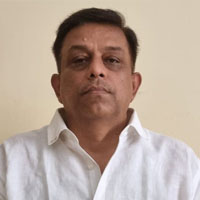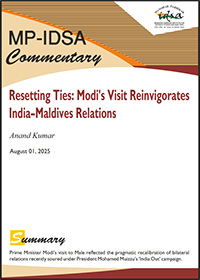Resetting Ties: Modi’s Visit Reinvigorates India–Maldives Relations
- August 01, 2025 |
- IDSA Comments
A Relationship Tested, Then Stabilised
India and the Maldives share millennia-old civilisational and cultural linkages rooted in geography and history. India was one of the first countries to recognise the Maldives after its independence from Britain in 1965. Over the decades, India stood by the Maldives during moments of crises, whether it was the 1988 coup attempt, the 2004 tsunami, the 2014 drinking water crisis, or the COVID-19 pandemic. India’s swift and generous responses have earned it the reputation of being the “first responder” in the Indian Ocean region.
However, the trajectory of this trusted partnership faced disruption when Mohamed Muizzu assumed office in November 2023. Having campaigned on a nationalist plank that demanded the removal of Indian military personnel, Muizzu’s initial foreign policy gestures seemed to tilt away from New Delhi. His decision to make China his first foreign visit broke with diplomatic convention. Derogatory remarks by some Maldivian officials targeting Prime Minister Modi added strain to people-to-people ties.[2] India’s dominance in South Asia and China’s rising profile in the Indian Ocean Region (IOR) further complicated bilateral perceptions.
Yet, just months into office, Muizzu began moderating his stance, realising that India’s goodwill and regional centrality were not assets the Maldives could afford to lose. The visit by Prime Minister Modi has therefore emerged as a diplomatic reset—both deliberate and necessary—for restoring equilibrium and confidence in the bilateral relations.
Modi’s Visit: Strategic Outcomes and Symbolic Messages
PM Modi’s visit was both substance-heavy and rich in symbolism. It marked the first bilateral trip by an Indian leader after the earlier tensions and coincided with the 60th anniversary of India–Maldives diplomatic relations. The Indian Prime Minister’s acceptance of the invitation from a leader who had run a campaign against Indian presence in the country reflects New Delhi’s maturity and strategic patience.
Among the key outcomes of the visit was the extension of a Rs 50 crore (US$ 565 million) Line of Credit (LoC) to the Maldives for development and security-related projects. India also agreed to reduce the Maldives’ annual debt repayment obligations on existing Government of India-funded LoCs. This step is significant, given the country’s mounting debt burden, especially to China, its largest external creditor.[3]
In an important economic milestone, both countries announced the commencement of negotiations for an India–Maldives Free Trade Agreement (IMFTA). This move can significantly boost bilateral trade, tourism and investments. This aligns with India’s broader goal of economic integration with its maritime neighbours under the ‘Neighbourhood First’ and ‘SAGAR’ (Security and Growth for All in the Region) doctrines.
Defence cooperation too received a major fillip. PM Modi and President Muizzu jointly inaugurated a new Ministry of Defence building in Malé, constructed with Indian assistance. India’s gifting of two Bharat Health Initiative for Sahyog Hita and Maitri (BHISHM) health cube sets for emergency medical and disaster support further reinforces India’s intent to be a comprehensive partner in security and human development.[4]
A commemorative stamp was jointly issued to mark 60 years of diplomatic relations in the realm of people-to-people ties. Infrastructure development also took centre stage: 3,300 social housing units in Hulhumalé were handed over; projects in Addu City and six High Impact Community Development Projects were inaugurated; and 72 vehicles and assorted equipment were provided to support public services. These initiatives demonstrate India’s ability to deliver visible and tangible developmental benefits.
The Strategic Context: Balancing China, Anchoring the Region
While Muizzu reiterated his desire to maintain balanced relations with both India and China, it is clear that the Indian Ocean is witnessing intensifying strategic competition. China’s often opaque and debt-inducing infrastructure financing has brought its own risks, as seen in other South Asian countries like Sri Lanka. With over 70 per cent of the Maldives’ external debt owed to China, its economic sovereignty is under strain.
India’s approach, by contrast, emphasises transparency, local ownership, and responsiveness to the priorities of partner countries. The fact that India replaced its military personnel with civilian technical experts on Maldivian request—without compromising the spirit of defence cooperation—is a testament to India’s flexible and non-intrusive diplomatic posture.
Moreover, the strong personal messaging during the visit was noteworthy. President Muizzu called India the Maldives’ “closest and most trusted partner” and declared that “no one can break India–Maldives ties”.[5] PM Modi, in turn, spoke of the Maldives’ “special place” in India’s Neighbourhood First policy, calling the relationship “not just diplomacy, but a relation of deep affinity”.[6] These statements signal a desire from both leaders to build political capital around stability and cooperation rather than confrontation.
Counterterrorism and Security Convergence
Another significant dimension of the reset is mutual security. President Muizzu’s condemnation of the April 2025 Pahalgam terror attack in India, which killed 26 civilians, signals alignment on counter-terrorism issues.[7] Frequent contacts between security agencies of both nations were acknowledged, reinforcing the belief that security in the Indian Ocean is indivisible and requires collaborative mechanisms.
The evolving maritime security environment—marked by piracy, illegal fishing, climate-induced challenges and militarisation by external powers—demands that littoral states like India and the Maldives work together. The India–Maldives reset, therefore, serves not just bilateral interests but contributes to regional stability.
Conclusion: A Relationship Reimagined
The diplomatic reset between India and the Maldives is a timely and strategic move for both countries. It reflects the effectiveness of sustained engagement, development diplomacy and principled flexibility for India. For the Maldives, it marks a recalibration that acknowledges India’s centrality and dependability without necessarily abandoning its outreach to China.
We are witnessing a pragmatic convergence: India seeks a stable maritime periphery for its global ambitions, while the Maldives needs a reliable partner for its economic and security needs. This mutual dependence, backed by shared values and geographical proximity, provides a durable foundation for bilateral cooperation.
Going forward, the focus must remain on consolidating this trust. Economic cooperation, capacity-building, maritime security and cultural exchanges must be deepened. Malé must avoid playing zero-sum geopolitical games, while India must continue to deliver on its promises with speed, scale and sensitivity.
The Modi–Muizzu handshake may well mark the beginning of a new phase in which India–Maldives relations are no longer vulnerable to political winds, but anchored in mutual respect, regional stability and strategic foresight.
Views expressed are of the author and do not necessarily reflect the views of the Manohar Parrikar IDSA or of the Government of India.
[1] Zunana Zalif, “PM Modi Returns to India after Fruitful Visit to Maldives”, Raajje.mv, 26 July 2025.
[2] “President of Maldives to Visit China Jan 8-12, Beijing Says”, Reuters, 5 January 2024.
[3] “List of Outcomes: State Visit of Prime Minister to Maldives”, Press Information Bureau, Prime Minister’s Office, Government of India, 26 July 2025.
[4] Ibid.
[5] “Maldives President Mohamed Muizzu Calls India ‘Most Trusted Ally’, Hails First Responder Role”, Hindustan Times, 26 July 2025.
[6] “India-Maldives Relations are Centuries Old: PM Modi in Malé”, ANI News, 26 July 2025.
[7] “Maldives President Condemned Pahalgam Terror Attack, Says Vikram Misri”, ANI News, 25 July 2025.





